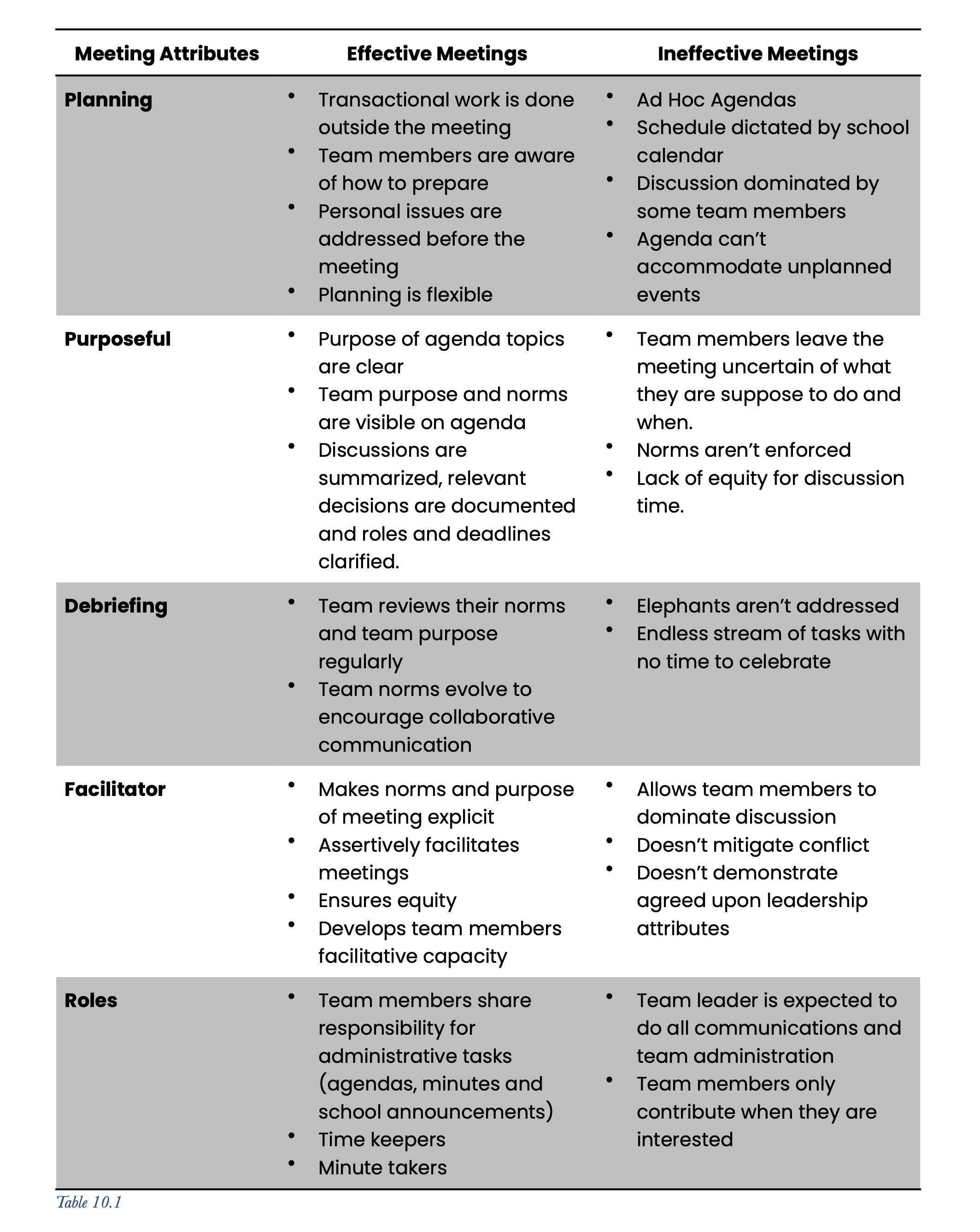Facilitating Purposeful Meetings
This article has been adapted from Chapter 10: Facilitating Purposeful Meetings of Michael Iannini’s book, Hidden in Plain Sight: Realizing the Full Potential of Middle Leaders.
During the first 6 to 8 weeks of the school year, team members, regardless of how long they have been at a school or even on a respective team, are preoccupied with their start of the school year rituals. These rituals can be quite observable in terms of how they go about clarifying their role and responsibilities and engage in cooperative, task driven, work with team members. It’s also during this period that unaddressed behaviours become norms, or what I refer to as Elephants in the Room. In the table below I identify several Elephants, or Ineffective Meeting Attributes and Behaviours, that team members will overlook at the start of the year because everyone is so busy.
When the Elephants go unaddressed they become the unspoken norms of the team. Within 60 to 90 days into the school year these unaddressed behaviors can lead team members to become disenfranchised with the work of the team. A good team leader recognizes these symptoms and addresses them head on; they take ownership of these Elephants and demonstrate to the team how to move past them. In the following article I provide guidance on how you can effectively plan and facilitate your team meetings.
To ensure your team can maintain and build on the good will and momentum from the start of the school, as a team leader you need to prepare to work 2-hours more per week to plan and facilitate purposeful meetings. Weekly forty- to sixty-minute meetings should be sufficient for teams to engage in more meaningful and interdependent work. Carefully planned and coordinated meetings ensure that when the team meets, they have a purpose. Effectively facilitated meetings ensure equity and can leverage conflict for individual and team growth.
Planning
I tell my workshop participants that even though they may meet once a week for forty to sixty minutes, to ensure that meeting is effective, it should actually be the culmination of two to three hours of planning and coordination activities. Leaders that invest the time to ensure the work of the team is purposeful will benefit by having team members who are more engaged with the work of the team. During the two to three hours of planning and coordination, several of the transactional items that take up meeting time will also be attended to, such as checking in on tasks that team members are meant to report on.
Given time to plan and coordinate, team leaders can ensure their members are given an agenda and relevant materials to review in advance. Questions and comments can be dealt with before the meeting. The meeting itself won’t become an excuse to plan or negotiate the demands of competing factions. Agenda items requiring time for processing or reflection can be dealt with outside the meeting, especially considering that each team member will process information differently. Members should come to meetings having already thought through the discussion points and prepared to contribute.
A final consideration when planning meetings is determining what ‘type’ of meeting it will be. Christine Comaford described three types of meetings in a Forbes Magazine article, “3 Types Of Meetings That Will Engage Your Team And Increase Team Performance.” Debriefing and forming activity meetings are for discussing why. In these meetings, we are surfacing values and beliefs and establishing or reaffirming vision and strategy. “What” meetings are for frontloading, ensuring all team members have a common understanding of what needs to be done and engage in ideation. Planning meetings are for deciding how the team will proceed and monitoring the team’s progress.
Each type of meeting has specific agenda items and these items have predictable results. For example, any agenda item that purposefully addresses why will take a long time to facilitate, as it provokes team members to surface their values and requires full participation to achieve buy-in. “What” meetings are opportunities to ensure a common understanding of the issues affecting the team and engage in brainstorming activities. “How” meetings, when prepared for appropriately, should lead to taking meaningful action that supports the team purpose. All of these meetings ultimately culminate in promises or requests for action based on the discussions being properly summarized and actions to be reported on the next meeting identified. Team members walk away from these meetings know what needs to be done, who will do it and when it is suppose to be done.
Facilitation
An effective meeting facilitator understands the purpose of the meeting and adapts their facilitation style to achieve that purpose. Defining meetings as “why,” “what,” or “how” is a simple and effective tool when you understand the facilitation style require to achieve the desired outputs for each type of meeting. Once established, you need to stay true to the intent of these meetings. An example of how a meeting purpose is undermined is when “how” meetings are used for the team leader to check in to ensure each person has finished grading or unit planning or has completed some administrative task. Team meetings are about the team; therefore, a good example of a “how” meeting is one that requires team members to report on work that informs the team of the challenges or progress of individual members working toward a team goal, such that other members can learn from that experience. In “how” meetings, team members should be collaboratively problem-solving and sharing experiences that benefit the team.
The next most important thing to remember to be an effective and influential meeting facilitator is to demonstrate and enforce the team’s agreed upon norms. The team’s norms are incredibly powerful facilitation tools. When crafted correctly, they are representative of the values and beliefs of all team members. When off-topic discussions erupt in meetings, ones that don’t support the team’s stated purpose, or when team members behave contrary to the agreed-upon norms, the facilitator has the power to invoke the collective will of the team to get the meeting back on track. In exceptional cases, though, a good facilitator will end a meeting if a discussion or norms infraction threatens any member of the team. A good facilitator will also question whether a meeting is necessary and should cancel meetings if the agenda items to be addressed don’t attend to the needs of all members. This puts an additional burden on the team leader, but it is a great way to build goodwill early on in a school year.
Lastly, facilitation is largely a communication skill. You need to know when and how to interject yourself into discussions. You need to be able to paraphrase and pause effectively. To communicate effectively, you need to be confident; this requires the right thinking. As the meeting facilitator, you have been entrusted with the responsibility of ensuring the meeting is purposeful and are the caretaker of the team’s norms and purpose. When discussions or behaviors conflict with the norms or purpose, it is your right to address those infractions on behalf of all team members.
When you invoke that right, you need to use the right language. When the time comes to interject in a heated discussion or if you need to interrupt someone, you do it by stating what you are observing and how you feel it may impact achieving the purpose of the meeting. When you have the right thinking and use the right language, your body should express the right behavior, in that it should be calm and non-aggressive. Ideally, all team members should have this skill, but often what happens is that a well-meaning discussion can devolve into personal experience–sharing or point-proving. If team members still feel their point or experience is valid, then a good facilitator will remind them of the time left for discussion and ensure they connect the point or experience to the meeting’s purpose.
Although being a good meeting facilitator is the hallmark of a good team leader, the ability to develop this skill in all team members is what makes for a great team leader. Team leaders should capacity-build the facilitation skills of the whole team. When policing behavior or directing discussions back to the mission of the team becomes the work of only one person, it is often indicative of only that one person being bought into the work of the team.





